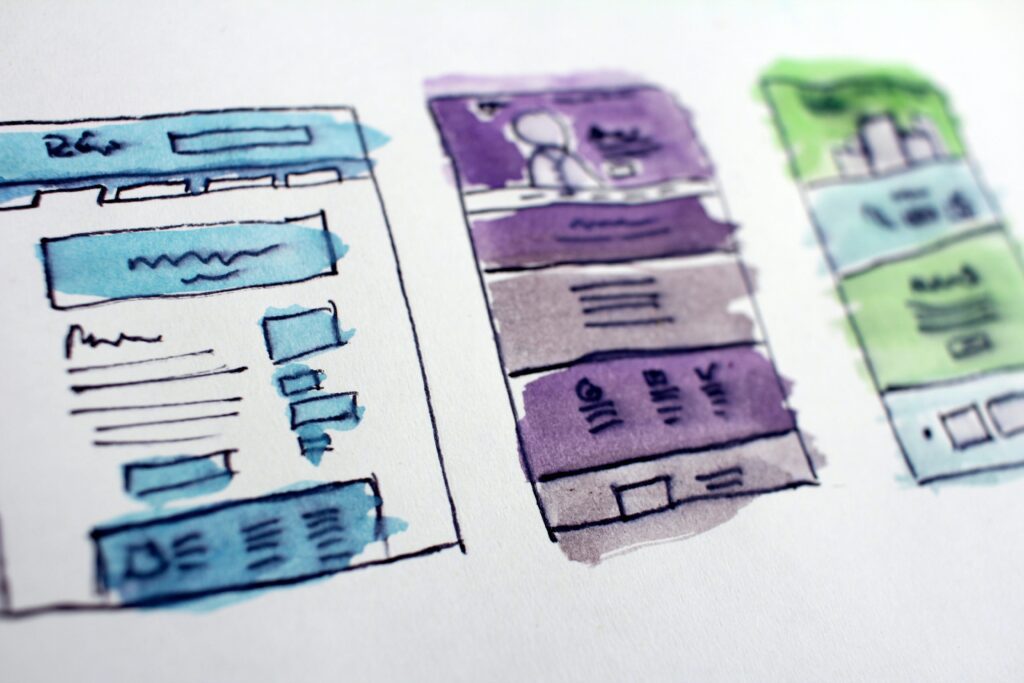A Beginner’s Guide To Usability Testing
Usability testing involves engaging actual users with your website, app, or any product you’ve developed, and carefully observing their interactions and responses.
Whether you begin with a modest approach like reviewing session recordings or opt for a more comprehensive approach such as renting a specialised lab with eye-tracking technology, usability testing is an essential phase in ensuring the creation of an effective, efficient, and enjoyable user experience.
What is Usability Testing?
Usability testing is a systematic approach for assessing the functionality of websites, apps, or digital products by observing real users as they attempt to accomplish tasks on these platforms.
Typically, researchers, often employed by a business, conduct this observation either in person or more commonly, during remote usability testing sessions. The primary objective of usability testing is to uncover areas of user confusion and identify pain points within the customer’s journey, thus pinpointing opportunities for enhancing the overall user experience.
This evaluation process aims to measure the practical effectiveness of the product, specifically how efficiently users can achieve predefined objectives.
How is Usability Testing Different To User Testing?
While user testing and usability testing share some common ground, their primary distinctions lie in their objectives and methodologies.
User testing primarily aims to comprehend users’ needs, identify issues, and assess how well your product resonates with them. In contrast, usability testing is considerably more focused on evaluating the functionality and user-friendliness of the product itself. To emphasise this difference, we can say that user testing revolves around the users, while usability testing centres more on the product.
Taking a broader perspective, usability testing can be regarded as one of the types of user testing. User testing serves as an umbrella term encompassing various methods and testing approaches, all with the common goal of gaining a deeper understanding of users and leveraging research data to design superior products. Consequently, usability testing can be viewed as one of the means to achieve this overarching objective.
Click here to see our in-depth guide to user testing.
What is Usability Testing Not?

Numerous UX and user testing tools contribute to enhancing the customer experience, but they do not fall under the category of ‘usability testing tools’ because they do not explicitly assess a product’s functionality. Here are some examples:
- A/B testing: A/B testing is a method for experimenting with multiple versions of a web page to determine the most effective one. While it can incorporate changes based on user testing, it does not qualify as a usability testing tool.
- Focus groups: Focus groups involve gathering a group of individuals to discuss a specific topic, often to gather opinions about a product or service. Their purpose is not to assess how users interact with the product, so they are not considered usability testing.
- Surveys: Surveys are used to gauge the user experience, but they do not allow direct observation of users in action on a website. Therefore, surveys are not classified as usability testing, although they can complement it through website usability surveys.
- Heatmaps: Heatmaps provide a visual representation of user interactions with a webpage, showing areas of high and low engagement. While they offer insights into aggregate user behaviour, they are not technically considered usability testing.
- User acceptance testing: This phase typically occurs towards the end of the software testing process and involves testers following a predefined set of steps to verify the software’s correct functionality. It focuses on quality assurance (QA) and is not designed to evaluate the product’s user-friendliness and efficiency.
- In-house user testing: Internal testing within a company is common, but it does not constitute usability testing. Employees may have inherent biases that prevent them from providing the candid feedback that real users can offer.
When Should I Run Usability Tests?
To ensure your product remains pertinent and effectively addresses your users’ most critical issues throughout its lifespan, it is imperative to conduct ongoing usability testing.
Before Designing
By conducting preliminary research, surveys, or even analysing competitors’ products, you can early on uncover user needs, expectations, and potential pain points. Armed with this valuable data as a reference point, you can embark on the design process with a strong foundation, ensuring the development of a user-centric product that is even more intuitive to use.
During Designing
In the design phase, users can provide opinions and offer usability insights on specific sections and components of the designs. This valuable feedback can expedite the enhancement of overall design features, making them more usable.
After Designing
Once you have complete designs, users can engage with the interface as a unified whole. This enables them to evaluate how effectively the overall user experience is maintained.
Before Product Launch
At this point, you have a functional, or nearly functional, product in hand. It’s now time to assess its overall effectiveness through summative testing. The objective of summative testing is to gauge the product’s performance using specific usability criteria such as efficiency, effectiveness, and user satisfaction. Each testing task should replicate typical user scenarios to provide meaningful insights.
Click here to learn more about the 39 other things you need to do before you launch your product.
Regularly After Launch
Even after your product is launched, it is vital to maintain its user-friendliness, accessibility, and relevance over time. By employing a consumer research tool, your team can conduct live website testing to identify and address issues stemming from browser updates, third-party integrations, or shifts in user behaviour patterns.
Why Do Usability Testing?

The objectives of usability testing can vary from one study to another, but they typically encompass:
- Identifying Design Issues: Uncovering problems within the product or service’s design.
- Exploring Improvement Opportunities: Discovering areas where enhancements can be made.
- Understanding User Behavior and Preferences: Gaining insights into the behaviour and preferences of the target users.
Why is usability testing necessary? Can’t a skilled UX designer create an excellent user interface? Even the most proficient UX designers cannot craft a flawless – or even sufficiently good – user experience without a process of iterative design informed by real user observations and their interactions with the design.
The realm of designing a modern user interface is rife with numerous variables, and the human brain introduces even more complexity. The potential combinations are vast. The only surefire method to achieve excellence in UX design is through rigorous testing.
8 Benefits of Website Usability Tests
Usability testing can benefit your website at any stage of its development, from the early prototype phase to the final product. Moreover, it’s a valuable practice to continue testing the user experience as you iterate and enhance your product over time. Employing real-user tests serves several key purposes:
- Prototype Validation: Introduce users in the early development stages to identify any issues or bugs. Verify whether your site or product behaves as expected during interactions. Testing with a prototype validates your concept, allowing you to plan future functionality before investing extensively in a complete website build. Click here to learn more about building your MVP here.
- Product Expectations Confirmation: After completing your product, conduct usability testing to ensure it meets intended expectations. Evaluate ease of use and identify any missing elements in the interface.
- Complex Flow Optimization: For functions involving multiple steps, like an e-commerce checkout process, conduct usability testing to ensure these processes are intuitive and straightforward.
- Complementary Insights: Usability testing can provide deeper insights into data collected from other methods. It helps explain the reasons behind certain data points, such as high visitor drop-off rates in your funnel analysis.
- Error Detection: Beyond major usability issues, usability testing uncovers minor errors like broken links, site glitches, and grammatical mistakes that may have been overlooked. It also validates fixes made after identifying these errors.
- Empathy Development: Usability testing encourages empathy for your website’s users. It offers a fresh perspective and helps the project team understand the challenges users face.
- Supporting Change: Usability testing provides tangible evidence of user struggles, making it easier to advocate for necessary changes within your organisation. Short clips of key usability testing findings can be persuasive tools for change.
- Enhancing User Experience: Ultimately, usability testing contributes to an improved user experience. Identifying hidden issues and addressing them ensures a more user-friendly and successful product.
Usability Testing Components
Usability testing encompasses various types, but at its core, it involves three essential components: the facilitator, the tasks, and the participant. During a usability-testing session, a participant interacts with a facilitator who assigns tasks and observes the participant’s actions.
The facilitator guides the participants through a series of tasks, keenly observing their behaviour and actively listening to their feedback. In some cases, the facilitator may ask follow-up questions to gain more in-depth insights.
In a usability test, the facilitator provides instructions and presents task scenarios to the participant. Simultaneously, the participant offers both behavioural and verbal feedback, sharing their thoughts and experiences with the interface as they complete the assigned tasks.
The Facilitator
The facilitator plays a crucial role in guiding the participant through the testing process. This includes providing clear instructions, addressing any questions the participant may have, and posing follow-up questions when necessary. Striking the delicate balance of obtaining high-quality, unbiased data without inadvertently influencing the participant’s behaviour is a challenging task that demands specialised training.
In a specific form of remote usability testing known as remote unmoderated testing, certain aspects of the facilitator’s role may be automated or handled by an application.
The Tasks
Usability test tasks are practical activities that simulate actions a participant might undertake in real-life situations. They can vary in specificity, ranging from highly detailed to open-ended, depending on the research objectives and the specific type of usability testing being conducted.
The wording of tasks is of paramount importance in usability testing. Minor errors in task phrasing can lead to participant misunderstandings or even influence their task performance due to a psychological phenomenon known as priming.
Task instructions can be communicated verbally, with the facilitator reading them aloud, or provided in written form on task sheets. It is common practice to have participants read the task instructions aloud to ensure they have thoroughly understood them. This approach also aids researchers in their note-taking, as they can always track which task the participant is currently engaged in.
The Participant
The participant should represent a realistic user of the product or service under investigation. This means the participant may already be an active user of the product or service in real-life scenarios. Alternatively, in some cases, the participant might share a similar background with the target user group or possess the same needs, even if they aren’t currently using the product.
During usability testing, participants are often encouraged to employ the “think-aloud” method. In this approach, the facilitator requests participants to articulate their actions and thoughts as they navigate through tasks. This methodology aims to gain insight into the participants’ behaviours, goals, thought processes, and motivations.
In a typical usability test session, the participant occupies the left side while the facilitator sits on the right. The participant utilises a designated testing laptop equipped with screen-recording software and a webcam to capture facial expressions.
Additionally, the laptop is connected to an external monitor for the facilitator’s use. The facilitator actively listens to participant feedback, administers tasks, and makes notes. The photograph captures the moment after the participant completes a task when the facilitator engages in follow-up questioning.
Types of Usability Testing
The selection of the appropriate usability testing method depends on the specific type of test you wish to conduct. Product research and testing can generally be categorised into three primary dimensions:
- Qualitative or Quantitative
- Remote or In-Person
- Moderated or Unmoderated
Qualitative vs. Quantitative
Usability testing can take either a qualitative or quantitative approach. Qualitative usability testing primarily focuses on gathering insights, observations, and anecdotal information regarding how individuals interact with a product or service. It is particularly effective at identifying issues within the user experience and is more commonly employed than its quantitative counterpart.
On the other hand, quantitative usability testing is centred around the collection of metrics that provide quantifiable descriptions of the user experience. Common metrics include task success rates and time spent on tasks. This method is well-suited for establishing performance benchmarks.
The number of participants required for a usability test varies depending on the study’s nature. For a standard qualitative usability study involving a single user group, it is recommended to involve around five participants. This number typically suffices to uncover the majority of prevalent issues within the product.
Remote vs. In-Person Testing
Remote usability tests have gained popularity due to their cost and time efficiency compared to in-person studies. There are two primary types of remote usability testing: moderated and unmoderated.
Remote moderated usability tests closely resemble in-person studies, with a facilitator guiding the participant through tasks. However, in this case, the facilitator and participant are in separate physical locations. Typically, moderated tests utilise screen-sharing software like Skype or GoToMeeting to facilitate interaction.
In contrast, remote unmoderated usability tests lack the same real-time facilitator-participant interaction found in in-person or moderated tests. Instead, researchers employ dedicated online remote-testing tools to create written tasks for participants. These participants complete the tasks independently at their convenience, with the testing tool providing task instructions and follow-up questions. Once the participant finishes the test, the researcher receives a session recording along with metrics such as task success.
In remote unmoderated usability testing, the traditional facilitator-participant interaction shifts as the testing platform takes on the role of administering tasks. The researcher designs the study, uploads task instructions onto the platform, and subsequently reviews the collected data, often by examining video recordings of the tasks.
Moderated vs. Unmoderated
Moderated and unmoderated usability testing represent two distinct approaches to evaluating usability.
In moderated usability testing, a moderator actively leads users through the test, whether in-person or remotely. They provide guidance, address participant inquiries, pose follow-up questions, and document observations made during the test.
In contrast, unmoderated usability testing, as the name implies, lacks moderator involvement. Users autonomously complete tasks, often utilising usability testing tools that capture their interactions and feedback without the need for real-time guidance.
The 10 Steps of Usability Testing
Regardless of the type of usability testing you employ, it’s essential to adhere to these 10 steps to gain a comprehensive understanding of your users’ needs and preferences.
1. Define Your Target Audience
The purpose of testing is to create a product that prioritises a positive user experience. To achieve this, it’s crucial to establish a deep understanding of your user base. Begin by posing questions such as:
- What is the demographic profile of your users (e.g., age, location, profession)?
- Which specific tasks do you intend for users to accomplish with your product (e.g., completing the checkout process, changing their username)?
- What timeframes are you aiming for in terms of task completion and overall interface navigation?
Once you have gathered these insights, formulate a clear problem statement that articulates the specific insights you seek.
For instance: “We aim to evaluate the usability of our product among customers aged 40-70, with a goal of completing the online checkout process within 2 minutes.” This well-defined statement will guide your choice of research methods and metrics for evaluating the user experience.
2. Find a Great Tool
Investing in a tool that streamlines your team’s usability testing efforts can yield substantial benefits. It’s advisable to opt for a tool that empowers your team to conduct rapid and scalable usability testing, both in the early stages of development and post-launch. This continuous research approach enables you to make informed design decisions, stay attuned to evolving user preferences, and ultimately retain a satisfied user base.
When evaluating usability testing tools, be on the lookout for key features, including:
- Live Website Testing: The ability to conduct usability tests directly on live websites or web-based applications.
- Prototype Testing: Seamless integration with design prototypes from platforms like Adobe XD, Figma, Sketch, and InVision, allowing for the validation of design concepts at an early stage.
- Usability Testing Templates: Access to pre-designed templates that expedite the setup process and ensure your tests are structured to capture relevant and actionable insights, saving both time and effort.
3. Determine Your Evaluation Criteria
How can you ensure that your team is assessing the right aspects? Defining your evaluation criteria is key to directing your team’s attention toward specific facets of the user experience. Depending on the objective of your test, it’s essential to consider and evaluate usability metrics such as:
- Task Completion Rate: The percentage of users who successfully complete specific tasks.
- Direct and Indirect Success: Assessing both direct task success (e.g., successful purchases) and indirect success indicators.
- Time-on-Screen: Measuring the time users spend on various screens or interfaces.
- Time-on-Task: Evaluating the time users require to accomplish specific tasks.
- User Satisfaction Score: Gathering feedback from users to gauge their overall satisfaction.
- Misclick Rate: Monitoring the frequency of unintentional clicks or interactions.
For instance, when assessing user accessibility during a checkout process, you can examine metrics such as checkout completion time and the overall success rate (i.e., the percentage of successful purchases).
Additionally, it’s advisable to establish benchmark test results using earlier prototypes or competitor products. This allows you to track user performance as your product evolves over time and ensures that your evaluations are effectively aligned with your objectives.
4. Create a Script
A meticulously prepared usability testing script delineates the tasks to be executed, provides clear instructions, and outlines pertinent questions to pose. It serves as a guide for the test participant, offering a structured path for navigation while also revealing any potential issues or areas for enhancement. To delve deeper into crafting your usability tasks and script, you can refer to Chapter Three for a comprehensive walkthrough.
5. Keep Your Tests Short
Maintain conciseness in your tests. The duration of a usability test should be tailored to factors such as the product’s complexity, the extent of testing objectives, and the level of participant engagement. However, as a rule of thumb, usability tests typically span an average of 15 to 20 minutes and include 5 to 10 tasks. Striking this balance ensures that the test remains brief enough to retain participants’ attention while affording your team ample time to acquire valuable insights.
6. Run a Pilot
To excel in usability testing, conducting a pilot run is a prudent step. Ideally, your pilot test participant should be an individual within your organisation who is not directly associated with your project, as they may carry preconceived notions about the product’s functionality. Alternatively, you could consider testing with a small group of participants who closely align with your target user demographic.
The pilot test serves as an evaluation of the clarity and effectiveness of your testing materials, including the script, tasks, and instructions. It also validates the feasibility of your chosen testing methods, tools, and environment. Think of it as a usability test for your usability testing process.
7. Find Test Participants
You can effortlessly enlist participants through three straightforward methods:
- Direct Invitations: Extend invitations directly from your website or browser-based products using popover invites.
- Tap into Existing Users: When testing an established product, consider sourcing testers from your current user base. Utilize recruitment tools like Reach to construct participant databases from your CRM, segment them, and despatch personalised emails.
- Leverage Panel Recruitment: Expedite participant recruitment by availing services from external providers.
When recruiting participants, take into account their availability and willingness to engage in the session. Scrutinize potential participants according to your criteria, and opt for those who align well with the objectives of the test.
8. Create a Good Testing Environment
Usability testing should resemble an interactive dialogue, not an inquisition. To maximise the benefits of your usability test, it’s imperative to educate your team on effective participant interaction while minimising bias. Researchers must steer clear of posing leading questions that could sway participants’ actions, and each participant should feel at ease when sharing candid feedback.
9. Analyze
When you convert raw data and participant feedback into actionable insights, you gain the ability to pinpoint user pain points, rank UX enhancements in terms of priority, and effectively communicate these findings within your team. Some key metrics that should be monitored include:
- Usability Metrics such as Total Testers, Bounce Rate, Misclick Rate, and Average Duration.
- User Flow Paths, detailing how participants interacted and conducting an analysis of optimal pathways.
- Success Metrics, which quantify how many testers diverged from the intended flow.
- Data from both Closed and Open-Ended Questions, presented visually to provide a comprehensive understanding of responses.
10. Iterate
Usability testing is a continuous endeavour that demands iteration, feedback incorporation, and revisions at every stage of the product’s lifecycle. You have the opportunity to assess various design iterations and scrutinise the outcomes to identify the most effective one. With the growth of your product and its user base, it becomes essential to periodically reassess your usability testing approach and tailor it to accommodate evolving objectives, user demographics, and market dynamics.
How Much Does Usability Testing Cost?
Basic, cost-effective usability studies can be conducted with relatively low expenses, typically requiring a few hundred dollars as participant incentives.
These testing sessions can occur in a standard conference room and are typically completed within three days (assuming you are already well-versed in the process and have access to participants):
- Day 1: Study planning
- Day 2: Testing with five users
- Day 3: Analysis of findings and the formulation of redesign recommendations for the next iteration
On the other hand, more elaborate research efforts may necessitate higher expenditures, potentially reaching several hundred thousand dollars for the most comprehensive studies. Factors that contribute to increased costs include:
- Comparative testing of multiple designs
- International testing spanning multiple countries
- Testing involving various user groups or personas
- Quantitative studies
- Utilization of specialised equipment like eye-tracking devices
- The requirement for a dedicated usability lab or focus group facility to accommodate observers
- The desire for an extensive analysis and a comprehensive report summarising the findings.
While advanced studies may not offer as high a return on investment (ROI) as simpler ones, they still present opportunities for valuable insights and improvements.
Overview
Usability testing transcends mere checkbox compliance in the development process; it stands as a formidable tool that can determine the fate of your product or interface. By extending invitations to genuine users to engage with your design, you unlock priceless insights into their needs, preferences, and pain points. This user-centric approach empowers you to refine your product, resolve usability challenges, and forge a resonant connection with your intended audience.
Usability testing isn’t a one-time event but rather an ongoing journey of enhancement. It equips you with the ability to make well-informed, data-driven decisions, ultimately conserving time, resources, and the potential for costly redesigns in the future. Moreover, a user-friendly design not only elevates user satisfaction but also sets you apart in a competitive landscape.
Embrace usability testing as an integral component of your development process, and witness the transformation of your product into a more user-centred, triumphant, and competitive offering. Your users will express gratitude, and your business will reap the benefits of a smoother, more gratifying user experience.
Now that you understand the fundamentals of usability testing, take a look at our complete guide to user testing and our advice on creating a usability testing script.







